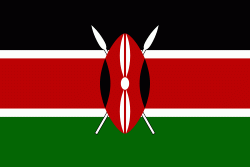Kirinyaga District (Kirinyaga)
Kirinyaga County is a county in the former Central Province of Kenya. Its capital is Kerugoya and its largest town is Wanguru. In 2019, the county had a population of 610,411 and an area of 1,478.1 km2. The county is bordered to the east and south by Embu County, to the south by a tiny part of Machakos County, to the southwest by Murang'a County and to the northwest by Nyeri County.
Kirinyaga county lies between 1158 and 5199 meters above sea level; its highest point is the summit of Mount Kenya.
Since the 2010 Constitution Kirinyaga County was led by Governor {Joseph Ndathi} from 2013-2017 then Anne Waiguru who was elected for her first term in 2017 and re-elected in the 2022 General Elections. She was also elected the chairperson of the Council of Governors (CoG) which she contested against Kajiado County Governor Joseph Ole Lenku.
Kirinyaga District was created in 1963 out of the western part of Embu District. Kerugoya town was the district headquarters. The district commissioner was based in this town. In 2007, Kirinyaga District was divided into four new districts:
* Kirinyaga Central with its administrative centre at Kerugoya
* Kirinyaga East with its administrative centre at Kianyaga
* Kirinyaga South with its administrative centre at Wanguru
* Kirinyaga West with its administrative centre at Baricho.
Kirinyaga county lies between 1158 and 5199 meters above sea level; its highest point is the summit of Mount Kenya.
Since the 2010 Constitution Kirinyaga County was led by Governor {Joseph Ndathi} from 2013-2017 then Anne Waiguru who was elected for her first term in 2017 and re-elected in the 2022 General Elections. She was also elected the chairperson of the Council of Governors (CoG) which she contested against Kajiado County Governor Joseph Ole Lenku.
Kirinyaga District was created in 1963 out of the western part of Embu District. Kerugoya town was the district headquarters. The district commissioner was based in this town. In 2007, Kirinyaga District was divided into four new districts:
* Kirinyaga Central with its administrative centre at Kerugoya
* Kirinyaga East with its administrative centre at Kianyaga
* Kirinyaga South with its administrative centre at Wanguru
* Kirinyaga West with its administrative centre at Baricho.
Map - Kirinyaga District (Kirinyaga)
Map
Country - Kenya
 |
 |
| Flag of Kenya | |
Kenya's earliest inhabitants were hunter-gatherers, like the present-day Hadza people. According to archaeological dating of associated artifacts and skeletal material, Cushitic speakers first settled in Kenya's lowlands between 3,200 and 1,300 BC, a phase known as the Lowland Savanna Pastoral Neolithic. Nilotic-speaking pastoralists (ancestral to Kenya's Nilotic speakers) began migrating from present-day South Sudan into Kenya around 500 BC. Bantu people settled at the coast and the interior between 250 BC and 500 AD. European contact began in 1500 AD with the Portuguese Empire, and effective colonisation of Kenya began in the 19th century during the European exploration of the interior. Modern-day Kenya emerged from a protectorate established by the British Empire in 1895 and the subsequent Kenya Colony, which began in 1920. Numerous disputes between the UK and the colony led to the Mau Mau revolution, which began in 1952, and the declaration of independence in 1963. After independence, Kenya remained a member of the Commonwealth of Nations. The current constitution was adopted in 2010 and replaced the 1963 independence constitution.
Currency / Language
| ISO | Currency | Symbol | Significant figures |
|---|---|---|---|
| KES | Kenyan shilling | Sh | 2 |
| ISO | Language |
|---|---|
| EN | English language |
| SW | Swahili language |















